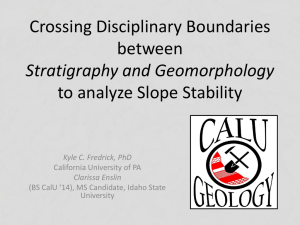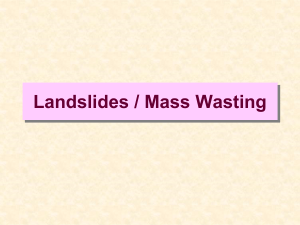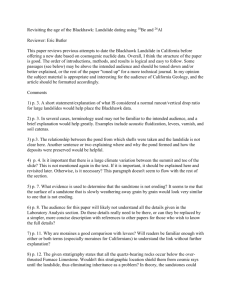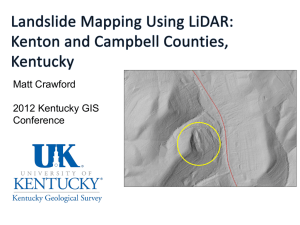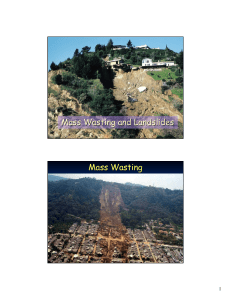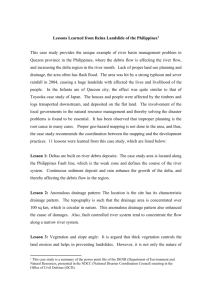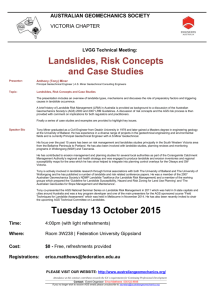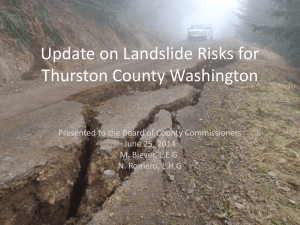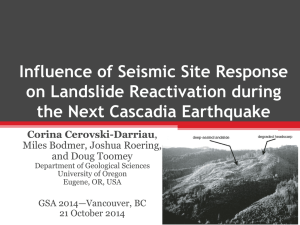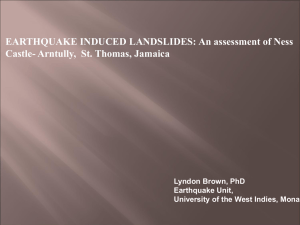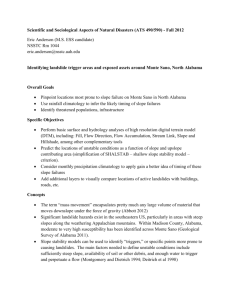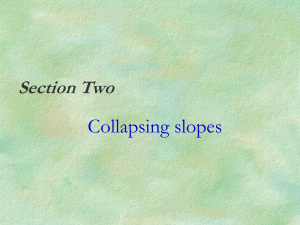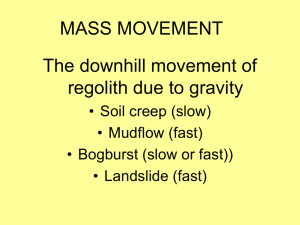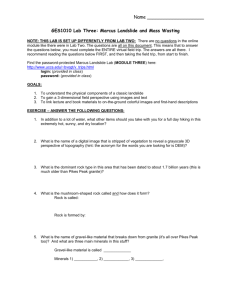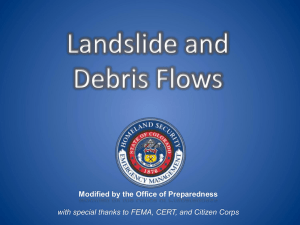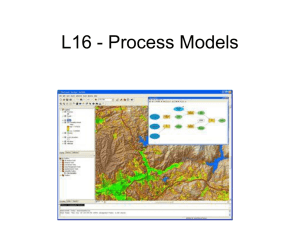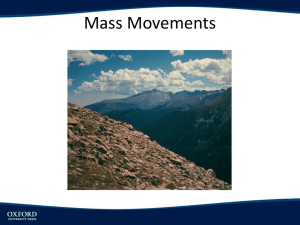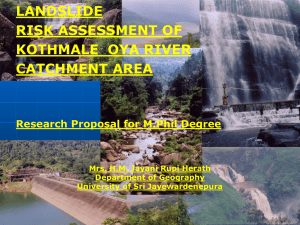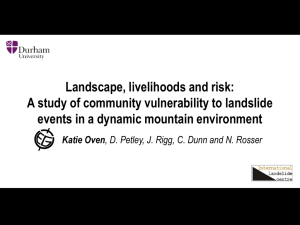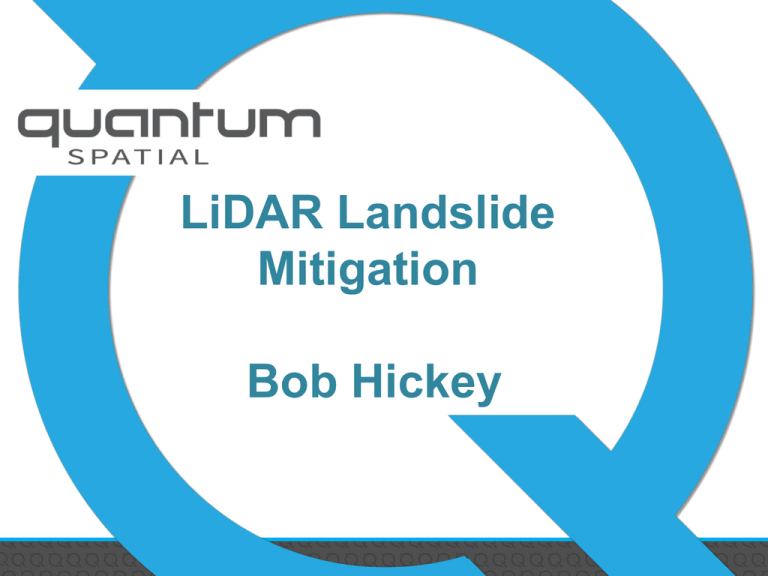
LiDAR Landslide
Mitigation
Bob Hickey
The term landslide includes a wide range of ground
movement, such as rock falls, deep failure of slopes, and
shallow debris flows.
Although gravity
acting on an
over-steepened
slope is the
primary reason
for a landslide,
there are other
contributing
factors
Causes • erosion by rivers, glaciers, or
ocean waves create over
steepened slopes
• slopes weakened through
saturation (Oso)
• earthquakes create stresses
causing weak slopes to fail
• volcanic eruptions produce
loose ash deposits, heavy
rain, and debris flows
• excess weight rain or snow,
stockpiling of rock or ore, from
waste piles, or from manmade structures
Landslides are a
serious geologic
hazard common to
almost every State
in the United
States.
Landslides in the
United States
cause
approximately $3.5
billion (year 2001
dollars) in damage,
and kill between 25
and 50 people
annually
(source geology.com)
Logan County Landslide (Dec, 2013)
100 people were “locked in” w/ cost of recovery est. over $1
million.
Academic Perspective
“West Virginia has one of the greatest landslide risks of any in
the country“. We may in fact have the highest per capita
landslide damage rate of any of the 50 states…more data is
needed to get a better grasp on the land”
Steve Kite, Chair of the Dept. of Geology & Geography at WVU
(Source: WV Public Broadcasting, April 25, 2014)
Source: USGS
Oso Landslide
• In March 2014 a landslide engulfed 49 homes and other structures in
an unincorporated neighborhood known as "Steelhead Haven“.
• It also dammed the river, causing extensive flooding upstream as
well as blocking State Route 530.
• Excluding landslides caused by volcanic eruptions, earthquakes
or dam collapses, the Oso slide is the deadliest single landslide
event in United States history.
• The mud, soil and rock debris left from the mudslide covered an area
1,500 ft (460 m) long, 4,400 ft (1,300 m) wide and deposited debris
30 to 70 ft (9.1 to 21.3 m) deep.
• 41 confirmed deaths, with 2 still missing.
OSO Video
Terrain Failure Detection
Methodology
• Incorporates existing techniques from published literature and
adheres to the rigors of scientific methods.
Statistical analysis has indicated terrain classification accuracy of
greater than 90%; a vast improvement compared to existing
detection methods. - (Martha & Van Den Eechhaut)
1. Martha, T.R., et al, 2013. Landslide
hazard and risk assessment using
semi-automatically created landslide
inventories. Geomorphology 184, 139–
150.
2. Van Den Eeckhaut, M., et al, 2012.
Object-oriented identification of forested
landslides with derivatives of single
pulse LiDAR data. Geomorphology 30–
42.
Methodology
• Ground-classified LiDAR points are
processed to create a variety of
raster images, which reveal landform
features unique to landslides and
faults.
• Input into QSI’s proprietary machine
learning tool include: shaded relief,
slope, roughness, plan curvature,
and other DEM derived topographic
characteristics
• Note: QSI’s proprietary tool builds
on the work with support of vector
machines by Chih-Chung Chang &
Chih-Jen Lin (ref:
www.csie.ntu.edu.tw/-cjlin/libsvm)
Methodology
High resolution LiDAR
penetrates dense forest
canopy resulting in a
high resolution ground
model. In addition to
facilitating a highly
automated failed terrain
classification process,
high resolution ground
models accentuate
critical geomorphology
and reduce instances of
omission and false
positives.
Methodology
Once the automated detection is complete, QC methods are
performed to eliminate false-positives, analyze potential omissions,
refine the geometry of slope failure delineations, and liniment
detections. Upon completion the areas are automatically assigned
respective slope angle, aspect, mean annual precipitation, vegetation
cover, and soil attributes.
Deliverables
Potential landslide hazard areas as attributed polygons (esri shapefile forma
•
•
•
•
•
•
•
•
•
•
Area of polygon
Average slope and aspect
Map unit symbol (standardized by US Soil Survey)
Soil unit name
Annual precipitation
Soil types found within polygon
Percent vegetation cover
Liquid Limit (LL)
Plastic Limit (PL)
Plasticity Index (PI)
Deliverables
Red Image Maps – Images composed of separate color
ramps that represent topographic openness, slope and
roughness
Google Earth KML of project area and all slope failure
areas. – The KML provides a shareable visualization of
the analysis that can be opened and viewed along with
satellite imagery
Attributed Soil Map (shapefile) as polygons. Soil types
and attributes are determined using the USDA Web Soil
Survey
LiDAR Derived Terrain Fault Analysis
Utilizing an automated approach, QSI has developed
and accurate and efficient methodology, that detects
areas of failed terrain using high-resolution LiDAR
data. The result is a robust and cost-effective dataset
that indicates the presence of landslides, fault line and
other forms of failed terrain.
Terrain Failure Detection
Video
Thank you
Openness is proposed as a visualization technique for the archaeological
interpretation of digital terrain models derived from airborne laser scanning. In
contrast to various shading techniques, openness is not subject to directional bias
and relief features highlighted by openness do not contain any horizontal
displacement.
Additionally, it offers a clear distinction between relief features and the surrounding
topography, while it highlights both the highest and lowest parts of features. This
makes openness an ideal tool for mapping and outlining of archaeological
features. A comparison with sky-view factor and local relief model visualizations
helps to evaluate advantages and limits of the technique.

